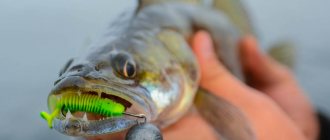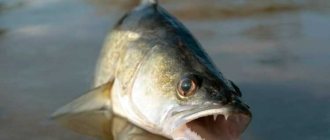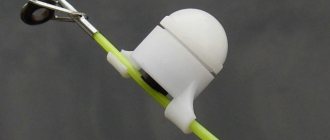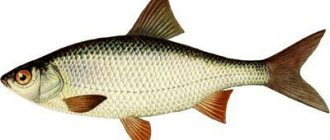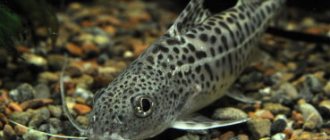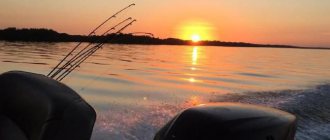Pike-perch fish is a freshwater predator belonging to the perch family. It has a slightly elongated body, tightly knit, laterally compressed. It has the face of a pike, but is large-mouthed like a chub and bug-eyed like a perch. It has teeth of different lengths, there are both fangs and smaller ones, which are not located in wide rows both on the jaws and on the dento-lingual bones.
Large pike perch The operculum is “decorated” with spines. The scales are small and tightly adjacent to the body, which makes the cleaning process very difficult. The upper back and head are gray-green, and the belly is white-yellow. The sides are surrounded by 10 to 12 black or brown stripes. The fins on the back and tail are gray-yellow with small dark specks, and the fins on the chest, abdomen and anal fin are sand-colored. The dorsal fins are separate. The fins must be handled very carefully to avoid injury.
With its eyes, a fish can distinguish light rays, and pike perch can also sense water vibrations. The fish has well-developed lateral vision. Pike perch, although a predator, is not particularly formidable due to its narrow throat. The male has a longer body than the female. Pike perch lives in schools, but during spawning the sexes separate. During the hunt, the pike perch first suppresses the prey, and then only grabs it. The fish can reach up to 8-10 kg in weight and have a length of 1.30-1.50 meters. Typically, the weight of pike perch does not exceed 1 - 3 kg, and the body length is 30-60 cm.
(The numerator indicates the average body length (weight) for a given age, and the denominator on the left indicates the minimum body length (weight) and on the right, separated by a “hyphen,” the maximum body length (weight) of pike perch is indicated.)
After spawning, pike perch returns to the schools. The exception is large individuals; they lead a solitary lifestyle. For the winter, fish group with carp families in their dens. The life expectancy of pike perch on average reaches up to 10 years. There are mainly two types of fish living in the Russian expanses: common pike perch and Volga pike perch , they are very demanding about the purity of water. Due to minor pollution, they can change their place of residence, look for bodies of water with clean water, a variety of food, and with a sandy or clay bottom. in swampy waters ; they are very sensitive to the lack of oxygen in the water.
Favorite habitats
This fish is an indigenous inhabitant of the Azov Sea basin. But at the moment, pike perch lives in rivers and lakes in Eastern Europe, in the Baltic and Black Seas.
Pike perch loves to be in holes, pools, deep depressions, as well as between stones, rhizomes and various breaks in the bottom topography. The pike perch spends its main time of the year at the bottom. Fish visit the surface of the bay and shallows at the time of spawning, or when they are carried away in the pursuit of prey; this race takes place mainly in the mornings and evenings. On windless and fairly clear evenings, pike perch can be seen in a flock on the surface of the reservoir.
At night, pike perch prefer shallow water. The fish like the bottom with sand, pebbles, stones and various rhizomes. It is well camouflaged in this environment due to its scale color. Cannot live in polluted water. If the water begins to deteriorate even a little, the pike perch leaves this body of water and moves up or, conversely, down.
Spinning fishing technique for pike perch
There are certain features of the pike perch fishing technique:
A cast is made to the intended fishing location. It is important to cast very far, 70-100 m. If fishing from the shore, at least 80 m.- Place the rod end up (or sideways). It is necessary to achieve such an effect that there is tension in the fishing line. Afterwards, watch the end of the rod. Weakening it means that the bait is on the bottom.
- Turn the reel a couple of turns toward you and do nothing for 3-6 seconds until the bait is at the bottom again. Then repeat the steps.
- When the bite ends, it is important to make a strong (biting) hook. The pike perch has a strong mouth, which means that if the force applied is insufficient, the fish simply spits out any bait.
- You need to fish with the help of friction clutches. This is done to dampen the jerks of large species of fish. The line must always be taut so that the pike perch does not free itself from the bait.
- Loosen up the walleye. We need to take him upstairs so he can swallow some air. After this, the fish will become weak enough to be picked up by the gills.
Catching pike perch at different times of the year
- Spring . The bite begins in mid-April. The first ten days of May are zest for pike perch. The fish gather in schools and move to the spawning site. A good place for fishing during this period is the boundaries of direct fast and reverse slow currents. At this time, monotonous casting in one good place, which needs to be determined by testing, is suitable.
- Summer . Fish are often found in stopovers. Predators are located in places where other fish gather. An echo sounder can be used to determine the location of such accumulations. In summer, fish are caught by casting in different places and pulling bait along the bottom. Wobblers and spoons are best suited for fishing during this period.
- Autumn . Fishing starts in September. The fish are located near deep holes, in pools or edges. The best is night fishing. The best baits will be soft fish (vibrating tails or twisters). The largest individuals are caught late in the fall just before the onset of cold weather. The wiring at this time is a jig. In autumn you need to make vertical movements with the bait.
Important tips when fishing for pike perch:
- The hooks must be very sharp in order to penetrate the strong fish mouth.
- Pike perch cannot be identified by splashes from the water, like pike. So there is no point in looking for it in this way.
- Fish can attack the bait at any time, both when standing and when moving the bait. It is important to make the cut in time.
- The full moon is a busy time for pike perch. During this period it is caught best.
- Cold water is not a reason to slowly drag the bait along the bottom. At any temperature, you need to quickly pull the bait and leave it in one place for a while.
- In autumn, pike perch prefers to be in places with still green algae. It's worth looking for him there.
- When cold weather sets in, pike perch tries to stay in warm places in the reservoir. Having identified them, you can stumble upon large concentrations of this type of fish;
Pike perch is a cautious fish. If fishing is done on the shore, it is important to disguise yourself and stand so that the silhouette is invisible. If you are fishing at depth in a boat, you should not make noise so that the fish does not stop looking for food.
Spawning
The spawning period for pike perch takes place in early spring, namely from April to early May, at a water temperature of 18-20 degrees. During spawning, pike perch goes to the floodplain bays and spawns there. Fish will not refuse a large pile in the water; it is also to the taste of pike perch during spawning. Spawning in this breed of fish is nesting.
The “mother” lays eggs at depth, mainly on the roots of aquatic plants, the male not only fertilizes, but also remains to guard first the eggs, and then the emerging babies. His responsibilities also include ventilating the eggs with his fins and cleaning the nest. The number of eggs depends on the age of the female (on average from 10 to 30 thousand).
After emerging from the eggs, the fry first feed on water mites, daphnia, cyclops, and various bacteria brought by the current. After 3 weeks, the predator instinct begins to wake up, and the fry eats brothers and sisters who are younger in age.
Features of fishing with a spinning rod on the rifts
> How to fish > Spinning > Features of fishing with a spinning rod on the rifts
Predatory fish love riffles; there is always something to eat there and a place for a successful ambush.
Therefore, spinning fishing on the rifts is very promising.
You can catch a variety of predators on the rifts, asp, chub, perch, pike, etc. Tactical techniques and correctly selected bait for catching a particular predator are very important here. Perhaps the most suitable time for fishing on the rifts is the second half of spring, summer and the first half of autumn. It is during these periods that predatory fish show maximum activity and fishing on the rifts with a spinning rod is the most interesting and exciting.
In hot summers, in many reservoirs in various places, there are many places where the oxygen content is very low and the fish feel very uncomfortable there. But riffles always have a comfortable oxygen regime, which the fish really like.
Tackle and equipment
To make the experience of spinning fishing on the riffles bright and impressive, it is best to use a light spinning rod with test values of 7-15 g. The length of the rod, depending on the size of the riffle, can vary between 2.1-2.7 m. Long casts on the riffles are unlikely Is it necessary since fishing takes place mainly on medium or small rivers. Models of high-quality spinning rods with medium-fast or fast action can send bait weighing 4-6 g at a distance of more than 35 m. Parabolic rods, which are more delicate and soft, are used by spinners for fishing at short distances.
Successful catching of predators on the rifts requires that the spinning rod be equipped with reels with a spool size in the range of 2000-2500. The reel must withstand significant loads in the process of fishing for an active asp or chub. either a thin braided cord or a rigid monofilament with a thickness of 0.18 to 0.22 mm is used as a base. The fishing line should have a low level of retention and should not be twisted by the current. Reels from the Ryobi Excia range are excellent for fishing on riffles. It winds the cord evenly onto the spool, is smooth and works excellently with braided cords with a thickness of 0.08-0.12 mm.
Fishing on riffles with a spinning rod has excellent prospects if you use Aglia Long spinners No. 00, 0.1 or Aglia No. 1, 2. On sunny days in the morning, spinners of golden or silver color work better. At lunchtime, you should use less bright baits, matte, brown or yellow. In the evening and at dusk, green or silver-colored baits are more catchy. When the weather is cloudy, bright baits are used mainly.
Fishing on riffles with a wobbler is very effective . For this, according to experienced comrades, the most suitable baits are those with a length of 3-6 cm. Sometimes wobblers about 8 cm long bring success. Some fishermen believe that it is most effective to fish on riffles with a wobbler, SS-minow. However, cranks of various colors work no worse.
Fishing on riffles with streamers also often has a positive effect. For fishing from the bottom or in the near-bottom layers, it is best to use silicone; it is most practical to fish with slugs or worms.
Where to look for a predator on the rifts
In most cases, spinning fishing on the rifts occurs by wading. In this case, the spinner in wading boots strives to get as close as possible to the promising point.
When the grass at the end of spring has not yet had time to grow much, fishing with a wobbler is very promising. At this time, you can use fairly thick fishing lines with a thickness of 0.22-0.24 mm. This line makes it possible to remove wobblers from the grass without loss.
You should also look for predators at the boundaries between islands and rifts; asp, pike and chub are most often caught there. Surface wobblers should be used in these places. The bait is launched behind the current, and the wiring is carried out against the current. In places where branches of bushes and trees hang over the water, chubs are most often caught. In this case, the wobbler must be sent under the branches of bushes or trees. Often the bite follows immediately. As soon as the wobbler falls on the water surface. In such places, wobblers of light green and green tones have the best performance.
On many rivers there are tiny flooded islands, but when the water recedes they can be clearly seen. Such islands provide good shelter for pike and chub; large humpback whales can often hide there. Various types of underwear also love such places. There is a lot of varied food that the fish are not averse to eating. You can often see schools of fry playing there, with small perches circling nearby.
The shallows are also attractive places for catching predatory fish. Usually in the shallows there is a large amount of a wide variety of aquatic grass, where both peaceful fish and predators can hide. If you conduct wiring near grass thickets, then it will quite provoke a grass pike or large perch to bite. Here you can use silicone frogs or small wobblers of light green or yellow color.
Spinning chub fishing with a frog often gives positive results near grass thickets. After all, frogs make up a significant part of the diet of this “peaceful” predator. Chub can hunt them both during the daytime and in the evening twilight.
If fishing on riffles occurs at night, then it is best to find small riffles where the bottom is covered with sand or pebbles. If a wobbler is used as bait, then it should have a driven body that resembles a bleak or a gudgeon. In such places, the most active bite is observed in the evening twilight, and lasts almost until midnight. The predator behaves very actively at such times, especially after the heat of the day.
Often riffles form near bridges and dams. Usually there the river narrows, and the depths rarely exceed 1-1.2 m. You need to look for places with a slow flow and use silicone baits or spoons there, using step wiring.
Features of catching various predatory fish in the riffles
Rifles are primarily the kingdom of the chub. Even those fishing enthusiasts who prefer other gear rather than spinning are well aware of this. Catching a handsome river fish in the seething waters of a riffle is not particularly difficult. This predator in sections of rivers where there are riffles often loses caution and actively attacks bait.
Another white predator, the asp, is also not averse to hunting in the rifts. Often its location is determined by bursts. And fans of spinning fishing begin to feverishly look for bait for asp in their arsenals. Typical asp baits are Castmaster spinners and some wobblers painted in bright colors.
Spinning pike fishing on the rifts is not as common as chub fishing. However, the spotted predator is often found there. Its searches primarily take place in places where there is a border between slow and fast currents. In most cases, the predator arranges ambushes at the exits to the rifts.
Perch is also a frequent guest of the riffles. It is recommended to catch large perch on the rifts with minnows or cranks.
Happy fishing!
Published: 07/27/2019
Other interesting materials:
| Why trout fishing is attractive There is nothing more exciting than trout fishing. What attracts her?... | About choosing bait The goal of any fisherman is to catch the biggest fish, but to do... | Summer grayling fishing on Lake Baikal Baikal is a huge lake with its own special ecology, ichthyofauna,… | Ice fishing on Lake Ladoga Lake Ladoga is one of the most popular fishing spots in the Leningrad region… |
Fishing Features
In summer, pike perch walks at a depth of up to 5.5 m, in the daytime, likes to change its parking location several times a day, but mostly during the day it sits out in its burrows. Before dawn it can be caught in shallow water, and already at about 5 am it can go slightly deeper into the reservoir, and by 10 am there is another changing place. Fishermen have noted the best hours for catching pike perch are 11 am, 3 pm, 6 pm.
To catch pike perch using live bait, the following fish are used:
- minnows
- bleak
- sprat
When the pike perch grabs the bait, it quickly rushes to the house with it, trying to swallow it whole as it goes. On the hook, the pike perch fights for freedom, but it is not strong in the fight and quickly gives up.
Finding pike perch habitats
Pike perch is a fairly large fish, which means it is not afraid of currents or deep places in reservoirs.
Habitats:
- The fish lives only in large deep rivers, deep lakes or reservoirs.
- Pike perch are sensitive to dirty water, so they can only live in the cleanest bodies of water.
- This type of fish is in constant motion. So you shouldn’t look for it in the same body of water in the same place.
- Pike perch is a predator. So often its location (for a while) is large stones, river mouths, especially if there are depressions or rocky ridges nearby.
- If there are large holes in the river - at the entrance/exit of them.
Where you won't find fish:
- “Dead zones” are areas heavily covered with silt.
- Places where water stagnates.
- Shallow waters (up to 1.5 m deep).
- Deep places with a flat bottom.
Peculiarities of pike perch behavior in different seasons of the year
The spring bite begins in the pre-spawning period from early April to mid-May. The bite is very good in high water, and when it declines it declines. The summer zhor begins in mid-June, after spawning, the pike perch is hungry, it absorbs food during the day. And in July there is no daytime fishing for pike perch. But the night “hunt” for this fish opens. With the onset of autumn cold weather, pike perch are more active and this period is the longest. The duration of autumn fishing is from mid-September until the first frost.
Autumn fishing is good in the morning and before sunset. In winter, when the ice has frozen the water, pike perch eat for up to 2 weeks. Then everything calms down, and you can start fishing in mid-January. As the ice melts, the water becomes enriched with oxygen and pike perch become active. When catching pike perch, you can alternate between playing and teasing passive baits in the form of worms, crayfish and other inhabitants of reservoirs. The fish does not have to run after the passive bait, but can grab it while swimming past.
Pike perch under the bridge
In my opinion, the main thing when catching pike perch is not bait or even wiring. The main thing is the correct choice of fishing location. It's no secret that pike perch are not found everywhere. A promising place at first glance may disappoint the fisherman with the absence of fanged fish. And no super-techniques or catchy baits will help: if there are no fish at the point, then there will be no fishing.
In the literature on pike perch fishing, the emphasis is often placed on the fact that this fish likes to stay in deep places with a hard bottom. Those. For successful fishing you need to find a section of the river with the necessary conditions. Finding a hard bottom is a fairly simple task if you have experience and good, sensitive gear in your hands. But for beginners who have neither experience nor the “right” gear, this task is difficult. Finding the right place can take a lot of time, and even if a novice angler thinks he has found the right point, he may simply be mistaken, and all his efforts to seduce the fanged will be unsuccessful. At one time, I also had difficulties finding pike perch sites. Rarely did I manage to find a normal place and even more rarely did I catch something! I started digging through the fishing literature and eventually found an interesting article about catching walleye near bridges. The author argued that a fanged fish is held under the pilings of any bridge and can be easily and very successfully caught with jig baits and diver wobblers. I immediately opened the map and found the nearest bridge across the Seversky Donets. Over the weekend I took a boat and went to a given point. He went down to the water, swam to the pilings at a distance of about 20 meters, tied a jig bait and began to fish. About 10 minutes later the first bite occurred and I had a one-kilogram fanged fish under my belt. The impact occurred right next to the pile. “Not bad,” I thought. I cast and move the bait along the same trajectory. I knew that pike perch is a schooling fish and where one pecked, there may be other individuals. And so it happened: on the second retrieve there was another blow and again a pike perch, although a little smaller than the previous one...
You can catch pike perch under the bridge pilings
In general, I caught 6 qualifying pike perch that day. The family was delighted! Since the day when there is a bridge in the place where I fish, I always fish points near the piles and in 80% of cases I catch pike perch. In my opinion, hunting for fanged fish near piles is well suited for novice fishermen who really want to taste fried zander and show off their trophy to their friends. The advantage of fishing under a bridge is that a person who wants to purposefully go out for pike perch can choose a fishing spot while sitting at home, focusing only on Yandex Maps! I can’t help but note: the fishing I’m talking about is technically simple. All that is required from the angler is the ability to make stepwise wiring of jig baits.
A few words about where exactly the fanged one can stay. On that first fishing trip, the bites occurred from the side of the pile opposite to the current. For some reason, I immediately guessed that the fanged one would stay right here - at the point where it does not waste energy fighting the river current (an area without a current is formed behind the pile). All subsequent fishing trips I fished only from the “quiet side”. But one day, when there was no bite, I decided to break through on the side of the current. To my surprise, on the 4th retrieve there was a bite and I caught a pike perch. And then from the same point I took out 3 more individuals. Near another pile, in a similar way, I caught two more fanged ones. At first I thought that this was just a local feature of the point, but experiments under other bridges showed that this was not a feature at all, but a widespread, everyday phenomenon. Walleye can really stand anywhere. Therefore, you need to carefully fish the entire area near the piles. If the piles are double, then you can fish in the clearing between them. As experience shows, pike perch also gather here.
The article is called “Pike perch under the bridge” and until this moment I paid attention only to the fanged one. But not only this fish likes to stand near piles. In the considered places you can catch large perch, pike, and catfish. Near the piles, right at the surface, chub and asp often gather. So if you fish under a bridge, then it is not at all necessary that you will have only one fanged one in your trophies. You can count on catching any fish, and with a high degree of probability.
Now, novice fishermen who want to catch pike perch will know where to look for fish without much effort and difficulty. Fish under bridges: I'm sure you'll have great results! No tail, no scales.
Silicone baits for pike perch
The aroma, color, weight, size of the bait are very important qualities for pike perch. In the summer, when pike perch are not eager to bite, flavored silicone can help the catch. This fish is “led” by the smell of fish and shrimp.
Vibrotail “Bugsy Snad-72” has a mackerel smell. Edible rubber is used for this bait .
Vibrating tail Bugsy Snad-72
The vibrating tail is suitable for various types of equipment. Twister “Tioga 100”, up to 100mm long, large fish made of rubber. The Ballist 63 vibrating tail combines a worm and a twister. This bait can copy the movements of a leech; the vibrotail itself is made of edible silicone, with the smell of shrimp.
Vibrating tail Ballist 63
Vibrating tail "Long john 07, 90, Pa 03", with the smell of mackerel. There is also an option consisting of a main braid, a working leash, which consists of a monofilament line from 0.28 to 0.3 mm, 1.5 meters and a braided cargo leash 0.16-0.20 mm, 30-40 cm.
Vibrating tail Long john 07, 90, Pa 03
Features of catching pike perch in different winter months
December
Typically, fishing for pike perch in December is done from the ice. If it is not there, you can choose a suitable steep bank, or a boat, since pike perch fishing takes place at relatively great depths.
In December, even if you do not take into account the high temperature, pike perch behaves quite actively and bites almost all day long. But the most productive time is considered to be dawn, or one hour before sunset.
Having an echo sounder can simplify the task of finding a school of pike perch. According to statistics, pike perch stops at the deepest points of the reservoir (more than 8 meters deep). If you find this point across the width of the river, you can notice 2 or 3 flocks of this predator in one place.
Good to know! Despite such activity, during sudden temperature changes, pike perch is located at shallower depths and reacts only to easy prey, which the fisherman must provide.
January
This month is called “dead winter” among fishermen, since reservoirs at this time have a deficiency of oxygen, and it is quite difficult to catch fish. She not only freezes, but also becomes lethargic. This is precisely the main reason for the lack of bite.
But this characteristic does not suit pike perch. Even in winter he is active and full of energy. That is why hunting for pike perch in January becomes even more active than in other months of the year.
You need to catch pike perch in January in clean places of medium depth, and in areas where there is water flow. Despite the high temperature, the predator still prefers to go out to “feed”, the main thing is to catch this moment.
Good to know! The main difficulty in January fishing will be the constant movements of a school of this fish, which is difficult to catch. It is impossible to develop effective tactics for catching pike perch; it all depends on chance and luck.
February
Fishermen call catching pike perch in February an exciting activity, because during this month the fish become capricious, aggressive, smart, and difficult to catch. For many this is a real challenge.
Pike perch prefers clean flowing lakes or rivers with sand and pebble soil, but is also found in other places. Moments of predator activity can be observed twice a day: early in the morning and a few hours before sunset.
When fishing for walleye in February, it is important to take into account that it changes its depth by 2-4 meters at sunrise, and is at a depth of approximately 5-8 meters in the middle of the day. With the onset of sunset the picture changes in the opposite direction.
The essence of catching pike perch in February, in fact, as in other winter months, is to find the location of the fish. Therefore, fishermen are often forced to move long distances along the banks.
Good to know! This predatory fish loves silence. Therefore, keep quiet when fishing, and when drilling holes, leave the outer layer of snow covering the ice so that large amounts of sunlight and light do not enter.
Texas rig
It is used in reservoirs heavily cluttered with various snags, where everyday equipment does not work. The equipment is quite simple in its structure. It includes an offset hook and a small, sliding, bullet-shaped weight.
Texas rig
All this is attached to the main scaffolding. The knot is tied a few cm from the hook to prevent the weight from moving around. The hook is not snagged, the bullet-shaped sinker, as well as the straight rigging allows the vibrotail to be retrieved with a catch.
Fishing from a bridge: pros and cons
Why is fishing from a bridge interesting for us?
Firstly, the bridge makes it possible to take a very convenient position, allowing you to cast far and carry the bait as you want - even close to any of the banks, even along the deepest longitudinal profile.
Secondly, you are on an elevation on the water - sometimes it’s a meter, and sometimes it’s seven or eight. This means that without compromising the quality of the casting, you can use the heads of relatively large weights - even though the depth within the casting range is small.
Thirdly, near bridges the bottom is often littered, and this is definitely a bigger plus than a minus when catching a predator. Whenever I fish in a section of a river where there are bridges, and the depths next to them allow me to hope for something (not to mention those bridges from which I have already managed to catch), I make sure to build my route so as to visit the each of them - and perhaps more than once. One of the episodes when from the high bridge on the river. Nare caught two little bees, even included in the video film of the “Modern Spinning” series. We were just filming a film about fishing on small rivers and at the same time we decided to check out a bridge from which we had never fished before. Everything happened within the boundaries of a populated area, and a crowd of boys gathered around who were delighted with what was happening. I really want to believe that the impressions they receive will sway their fishing habits in favor of spinning. The trouble was that soon after that, that entire section of Nara was destroyed by “electricians.” The next winter I visited Nara three times - to the very places where before, out of a dozen fishing trips, not a single one was empty. Now it’s completely zero.
I will not give a lecture on the harmful effects of electrofishing.
To one degree or another, everyone knows about them - both those who practice this type of “fishing” and those who are ready to mercilessly lynch “electricians” on the spot. The fish is very unlucky that it lives in the reservoirs of that country and at a time where there are no effectively working environmental laws, and the authorities and security forces designed to enforce these laws are themselves sometimes involved in criminal activities. And the story that people come to electrofishing out of desperation—the inability to feed themselves and their families in any other way—sounds very unconvincing. Most people who are not poor do this. You can “kill” a small river with an electric rod almost in one day - it is unlikely that any of the residents of the village standing on the bank will do this. We can only hope that the dominance of “electricians” will end in the near future. How is no longer so important. The goal is such that any means to achieve it can be justified. This, however, is my personal opinion - you have the right not to share it, but judging by the fact that you currently have a book on spinning in your hands, this tackle is closer to you than the “electric fishing rod”, and, most likely, we think equally... In continuation of the general topic, it is worth briefly touching on another evil that small (and not only small) rivers suffer from - poor ecology. But this evil is not so harmful, judging by the fish. Among the rivers of the Moscow region, perhaps the first place in terms of the multiplicity of exceeding all possible maximum concentration limits belongs to Pekhorka - from Lyubertsy to the mouth. At the same time, the river is teeming with fish. Moreover, at my request, ecotoxicologist V. Lebedev analyzed several fish from small rivers near Moscow, including Pekhorka, and it turned out that the permissible limit for the content of heavy metals was not exceeded. There are, however, also phenols, pesticides, and petroleum products. In terms of petroleum products, judging by the organoleptic perception (that is, taste and smell), the fish from Pekhorka and several other rivers is by no means sterile, but this should not worry us too much, because the time has come to reconsider the stereotypes according to which everything that is caught must certainly be eaten. This applies not only to reservoirs with unfavorable ecology, but, of course, the “catch and release” rule applies primarily to them. The warm water that makes rivers “evergreen” comes mostly from wastewater treatment plants. The degree of purification can be very different, including very high, however, those places where water from treatment sewers enters the river are usually called by winter spinners the not-so-euphonious word “shit drain.” Each such “shit dump” has a very noticeable effect on the condition of the water in the river and its inhabitants. The concentration of fish and their behavior above and below the warm water discharge are sometimes radically different. And if we are talking about heat-loving fish, then it is often tied to the “shit plum” throughout the winter. Of the predatory and conditionally predatory fish that we catch on small rivers, this applies primarily to chub and bleak. The craving for warm water among “white” predators sometimes manifests itself very clearly: they are often caught only in an area several tens of meters down from the “shit drain”, even lower, as well as above, they seem to be absent at all - at least they are found there much less often. The intensity of discharge from treatment plants usually has a pronounced daily cycle: in the morning the flow of warm water is minimal, then it increases and reaches a maximum somewhere in the afternoon. The fish adapts to this schedule: early in the morning, if you carefully approach the outlet of the collector, you can sometimes notice chubs standing as close as possible to the source of warm water. Later, as the discharge intensifies, the chubs move away from it. Accordingly, the bites - in the morning they often occur under the very “shit drain”, in the afternoon - somewhat lower, where the water from the collector is already mixed with the colder water of the river. The flow of water coming from the treatment sewers is comparable to the same indicators for the entire river. This means that, taking into account the daily cyclicality of “shit drainage” drains, such an important hydrological parameter as the water level in the river is subject to daily fluctuations. In the morning (at nine o'clock) it is minimal, in the middle of the day (until three o'clock) it increases. This is not noticeable on all rivers, but it happens that the level difference reaches twenty centimeters or more within a few hours; and so on every day, except perhaps on weekends. For a small river such a jump is very significant, and the fish cannot help but react to it. The reaction of pike to the daily variation of the water level is manifested in the fact that its best bite occurs in the second half of the day, especially in the period from two to four hours in the afternoon. Let me note once again that this pattern only works on those rivers where the water level experiences noticeable fluctuations with a maximum at this very time. Why are pike most active when water levels are high? There are many versions that can be proposed. For example, high water and a stronger current encourage white fish to move more actively (this is indeed the case), and pike, when going out to feed, simply take advantage of the fact that the prey itself is exposed. Or this option: in high water, better jigging is achieved, which directly affects the number of bites. Perhaps the reason is something else, but this is not so important, the consequence is more important: the ratio of pike bites before and after noon is somewhere from 1:2 to 1:3, and in very rare cases in the morning, in low water , manages to catch more. The water level in a small river depends, of course, not only on the intensity of discharges from all sorts of “shit drains”. Natural factors influence the river, perhaps with less regularity, but the level jumps they cause are often significantly larger. Article on the topic: What kind of fish is carp?
